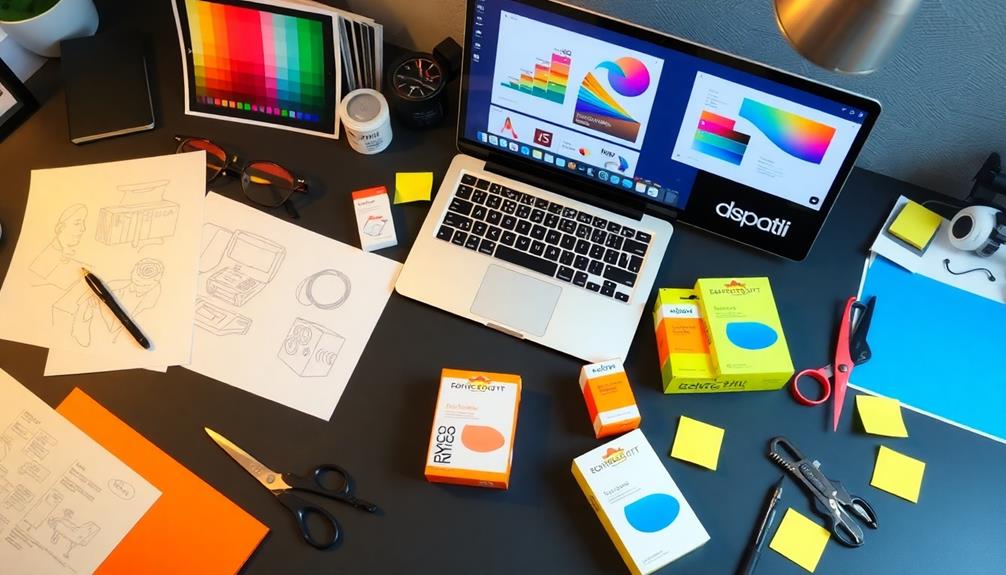Creating your first digital product starts with brainstorming ideas based on your interests and expertise. Validate your concept by researching your target audience's needs and preferences. Once you settle on a product type, like an eBook or course, focus on crafting high-quality content that truly addresses their pain points. Pay attention to your design; it should be visually appealing and consistent with your branding. Finally, build anticipation for your launch through social media and email campaigns. With a well-strategized launch, you'll attract enthusiastic customers. There's much more to explore that can elevate your product journey.
Key Takeaways
- Identify your target audience by analyzing their demographics, interests, and pain points to tailor your product effectively.
- Brainstorm product ideas that align with your expertise and address common problems or knowledge gaps within your audience.
- Choose a suitable format for your digital product, such as eBooks or online courses, based on audience preferences and market demand.
- Create high-quality content that provides value, utilizing design tools to enhance visual appeal and engagement through multimedia elements.
- Develop a marketing strategy that includes social media promotion, email marketing, and a compelling sales page to drive product launch success.
Idea Generation

Generating ideas for your first digital product starts with tapping into your interests and expertise. Think about what you're passionate about and where your skills lie. This brainstorming session is essential for effective idea generation.
By fostering a sense of curiosity and exploration, you can reveal new insights that may lead to innovative product ideas. Once you've gathered some potential digital product ideas, it's time to conduct market research. Use tools like Google Trends to validate the demand for your concepts by analyzing search interest and consumer behavior.
Next, identify common problems or knowledge gaps within your target audience. Understanding these issues allows you to develop solutions that provide real value and meet their specific needs.
To gather insights, engage with your audience through social media polls or feedback requests. This direct interaction can shed light on their preferences and interests regarding potential product topics.
Don't forget to explore existing digital products in your niche on platforms like Etsy or Udemy. This helps you identify gaps in the market and discover high-demand opportunities with low competition, increasing your chances of success.
Defining Your Product

After brainstorming and validating your digital product ideas, it's time to define your product clearly. This step is essential for guaranteeing you create a digital product that resonates with your target audience.
With the increasing interest in digital entrepreneurship and the potential for passive income through online business models, defining your product effectively can set the foundation for your success.
Here's how to do it effectively:
- Identify Your Target Audience: Analyze demographics, interests, and pain points to guarantee your product meets their specific needs.
- Determine the Format: Choose the right format for your digital product, such as eBooks, online courses, templates, or digital art, based on your audience's preferences.
- Outline Unique Benefits: Clearly define the unique benefits your product offers. What sets it apart? Your value proposition should highlight these features.
- Conduct Market Research: Validate your product idea by evaluating demand and competition. Focus on gaps in the market that your product can fill.
Additionally, consider how trends in affiliate marketing insights can inform your product strategy.
Content Creation

Creating compelling content is vital for the success of your digital product. Focus on producing high-quality, valuable content that addresses your target audience's needs and pain points. This relevance enhances your product's appeal and effectiveness.
Allocating sufficient time for content creation is essential; rushing can compromise the quality and value of what you offer. Incorporating high-quality content boosts credibility and trustworthiness, which can greatly influence your audience's perception.
Utilize user-friendly design tools like Canva or Adobe InDesign to create visually appealing layouts that reflect your brand identity. A polished design can greatly impact audience engagement and perception of your product.
Don't forget to incorporate multimedia elements such as videos, audio files, or interactive quizzes. These can enhance the learning experience and keep your audience interested.
Regularly review and edit your content to guarantee it remains polished, error-free, and provides the most helpful information. The goal is to create a digital product that not only informs but also engages your audience effectively.
Design and Packaging

An eye-catching design can make a significant difference in how your digital product is perceived by potential customers. Effective packaging not only attracts attention but also enhances perceived value.
For instance, utilizing high-quality visuals can greatly enhance the overall impact of your product, much like how color accuracy in projectors affects image quality.
Here's how to create an appealing design:
- Utilize Design Tools: Use user-friendly tools like Canva or Adobe InDesign to craft professional-quality graphics that reflect your brand identity.
- Consider Hiring a Designer: If you lack design skills, hiring a professional graphic designer can elevate your product's appeal and guarantee high-quality packaging.
- Maintain Consistency: Verify your design aligns consistently across all marketing materials and digital products. This reinforces brand recognition and builds trust.
- Incorporate Engaging Visuals: Enhance the user experience by integrating attractive layout elements and engaging visuals within your product.
Launch and Promotion

Once you've crafted an appealing design and packaging for your digital product, it's time to focus on launching and promoting it effectively. Building anticipation is essential; engage your audience with sneak peeks, discuss their struggles, and share product outlines to create excitement.
Consider implementing strategies from market smarter techniques to reach a wider audience.
To promote your digital product, leverage social media and email marketing. Utilize platforms like Facebook and Instagram to reach a larger audience and drive traffic to your sales page. A well-designed sales page showcasing benefits, features, and testimonials can greatly enhance your digital product's credibility and appeal, making it easier for you to sell digital products successfully.
Consider offering limited-time discounts or bonuses during your launch to incentivize early purchases and create a sense of urgency among potential buyers.
Once you launch and sell your online course, don't let the momentum fade. Maintain consistent promotional efforts by updating your email welcome sequence and creating a sales calendar. This way, you keep your product visible and encourage ongoing digital product sales, paving the way for passive income.
With these strategies, you'll effectively promote your digital product and maximize its potential.
Frequently Asked Questions
How to Create a Digital Product for Beginners?
To create a digital product, start by brainstorming your interests and expertise. Validate your idea through market research, choose a suitable format, outline your content, and plan a marketing strategy to reach your audience effectively.
How Do You Create a Digital Product Design?
To create your digital product design, start by identifying your audience's needs. Use tools like Canva for visuals, add multimedia elements, guarantee high-quality packaging, and gather feedback to refine your design effectively.
How to Launch a Digital Product?
Launching a digital product isn't just about the final reveal; it's about the journey. You'll spark excitement through sneak peeks, choose the right platform, and promote relentlessly to guarantee your product shines when it's live.
What Is the Most Profitable Digital Product?
The most profitable digital product often combines e-books, online courses, or software tools. You'll find success by identifying niche markets with high demand, creating valuable content, and addressing specific problems your audience faces.
Conclusion
Creating your first digital product can be an exciting journey. Did you know that 82% of entrepreneurs claim that their digital products markedly boosted their income? By following the steps of idea generation, defining your product, content creation, design, and launching, you're setting yourself up for success. Remember, every great product started with a simple idea. So, take the leap, put your plan into action, and watch your vision come to life!










